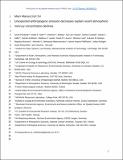Unexpected anthropogenic emission decreases explain recent atmospheric mercury concentration declines
Author(s)
Feinberg, Aryeh; Selin, Noelle E.; Braban, Christine F.; Chang, Kai-Lan; Custódio, Danilo; Jaffe, Daniel A.; Kyllönen, Katriina; Landis, Matthew S.; Leeson, Sarah R.; Luke, Winston; Molepo, Koketso M.; Murovec, Marijana; Nerentorp Mastromonaco, Michelle G.; Aspmo Pfaffhuber, Katrine; Rüdiger, Julian; Sheu, Guey-Rong; St. Louis, Vincent L.; ... Show more Show less
DownloadFeinberg_Hg_trends_postprint_merged.pdf (3.453Mb)
Open Access Policy
Open Access Policy
Creative Commons Attribution-Noncommercial-Share Alike
Terms of use
Metadata
Show full item recordAbstract
Anthropogenic activities emit ~2,000 Mg y−1 of the toxic pollutant mercury (Hg) into the atmosphere, leading to long-range transport and deposition to remote ecosystems. Global anthropogenic emission inventories report increases in Northern Hemispheric (NH) Hg emissions during the last three decades, in contradiction with the observed decline in atmospheric Hg concentrations at NH measurement stations. Many factors can obscure the link between anthropogenic emissions and atmospheric Hg concentrations, including trends in the reemissions of previously released anthropogenic (“legacy”) Hg, atmospheric sink variability, and spatial heterogeneity of monitoring data. Here, we assess the observed trends in gaseous elemental mercury (Hg0) in the NH and apply biogeochemical box modeling and chemical transport modeling to understand the trend drivers. Using linear mixed effects modeling of observational data from 51 stations, we find negative Hg0 trends in most NH regions, with an overall trend for 2005 to 2020 of −0.011 ± 0.006 ng m−3 y−1 (±2 SD). In contrast to existing emission inventories, our modeling analysis suggests that annual NH anthropogenic emissions must have declined by at least 140 Mg between the years 2005 and 2020 to be consistent with observed trends. Faster declines in 95th percentile Hg0 values than median values in Europe, North America, and East Asian measurement stations corroborate that the likely cause is a decline in nearby anthropogenic emissions rather than background legacy reemissions. Our results are relevant for evaluating the effectiveness of the Minamata Convention on Mercury, demonstrating that existing emission inventories are incompatible with the observed Hg0 declines.
Date issued
2024-10-08Department
Massachusetts Institute of Technology. Institute for Data, Systems, and Society; Massachusetts Institute of Technology. Department of Earth, Atmospheric, and Planetary SciencesJournal
Proceedings of the National Academy of Sciences of the United States of America
Publisher
Proceedings of the National Academy of Sciences
Citation
Feinberg, Aryeh, Selin, Noelle E., Braban, Christine F., Chang, Kai-Lan, Custódio, Danilo et al. 2024. "Unexpected anthropogenic emission decreases explain recent atmospheric mercury concentration declines." Proceedings of the National Academy of Sciences of the United States of America, 121 (42).
Version: Author's final manuscript
ISSN
0027-8424
1091-6490